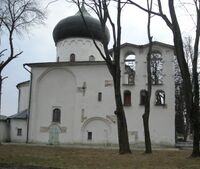Nifon de Novgorod
| Acest articol (sau părți din el) este propus spre traducere din limba engleză!
Dacă doriți să vă asumați acestă traducere (parțial sau integral), anunțați acest lucru pe pagina de discuții a articolului. |
Cel întru sfinți Părintele nostru Nifon de Novgorod, sau Nifont de Novgorod, a fost father among the saints Nifont of Novgorod, also Niphon of Novgorod, a fost arhiepiscop de Novgorod în prima jumătate a secolului al XII-lea. A desfășurat o puternică mișcare o evanghelizare a triburilor păgâne din nord-estul teritoriilor din jurul cetăților Novgorod și Pskov și a încurajat înființarea unor mănăstiri în care călugării să fie ei înșiși deschiși către lucrearea misionară. Sub păstorirea lui s-au construit catedralele din Novgorod și Pskov. Prăznuirea lui în Biserica Ortodoxă se face pe 8 aprilie.
Viața
Sfântul Nifon a fost călugăr la Mănăstirea Peșterilor din Kiev în zilele egumenului Teodosie și a urmat în viața virtuoasă a marilor cuvioși părinți ai lavrei, ostenindu-se în rugăciune, priveghere, post și în alte nevoințe.
Când fericitul Ioan, episcopul Novgorodului, a renunţat la scaunul episcopal în care se ostenise timp de douăzeci de ani - din propria dorință, pentru că era bătrân și slăbit - și s-a retras la o mănăstire, atunci fericitul Nifon, strălucind cu razele numeroaselor sale virtuți, cu voia lui Dumnezeu, a fost ales episcop al scaunului Novgorodului şi hirotonit de mitropolitul Mihail al II-lea, în anul 1130.
As much of the area around Novgorod was largely pagan, Nifont chose to concentrate his missionary efforts, first, around Pskov, and then the area of Ladoga, where he laid the cornerstone of the Church of St. Clement in 1153.
After Bp. Nifont’s arrival in Novgorod, the political situation began to shift to election of a “ruling” prince from the local area over one from Kiev. In 1136, the Kiev backed Prince Vsevolod Mstislavich, son of Mstislav Vladimirovich and grandson of Vladimir Monomakh, was banished from Novgorod and replaced by Prince Svyatoslav Olgovich. Prince Vsevolod found refuge in the town of Pskov, a rival of Novgorod. Soon, Bp. Nifont joined Vsevolod in Pskov after he refused a second marriage for Prince Svyatoslav that was against the Church canons. This exile lasted until about 1142.
As part of his evangelical zeal, Bp. Nifont had initiated before his exile a program of repairing and building churches in Novgorod, notably construction of Dormition Cathedral on the market square, in 1135. With his exile to Pskov, Bp. Nifont launched an active evangelistic program in the Russian territories adjacent to the town. Pskov became a center of church and monastery building. Between 1137 and 1142, two monasteries were started in Pskov, the Mirozhsky and the Nativity of St. John the Baptist of Ivanovsky Monasteries, monasteries in which the new missionaries were trained in spreading Christian ideals with sermons that bore personal examples of asceticism. At Mirozhsky Monastery, he also initiated the building of the Transfiguration Cathedral with twelfth century frescos that have survived to today.
After the repose of Metr. Michael of Kiev in 1145, the Grand Prince Isiaiaslav moved to have the schemamonk Clement consecrated to the Kievan see without the blessing of the Patriarch of Constantinople. At a council of bishops, Abp. Nifont voiced his disapproval of this action, advising the council that it was contrary to the tradition of the Russian Church as the Church had received the Orthodox faith from Constantinople. The consecration of Clement took place regardless of Abp. Nifont’s objection. Abp. Nifont thereafter refused to serve with Metr. Clement nor to commemorate him during services.
Clement in turn refuse to let Nifont return to Novgorod, keeping him under house arrest at the Kiev Caves Monastery. After Prince Isiaiaslav was defeated by Prince George I in 1149, Abp. Nifont was released and allowed to return to a joyous Novgorod. Praising in a letter Abp. Nifont’s defense of the traditions of the Church, the Patriarch of Constantinople sent Metr. Constantine to Kiev to depose Clement and assume the see in Kiev.
Abp. Nifont returned to Kiev to meet the new metropolitan, taking up residence again at the Kiev Caves Monastery. While at the monastery, Abp. Nifont became ill. On April 8, 1156, Abp. Nifont reposed after he had seen in a dream thirteen days before St. Theodosius who had told him of his coming death.
| Nifon de Novgorod | ||
|---|---|---|
| Precedat de: Ioan |
Episcop de Novgorod 1130-1156 |
Urmat de: ? |
Surse
- Sinaxarul Părintelui Macarie de la Simonos Petras
- https://www.crestinortodox.ro/sfinti/sfantul-nifon-episcopul-novgorodului-151563.html
- St Niphon the Bishop of Novgorod
- V. Sarabianov, Transfiguration Cathedral of the Mirozh Monastery, Severny Polomnik, 2002 ISBN 5-94431-033-2
Categorii > Istoria Bisericii
Categorii > Istoria Bisericii
Categorii > Liturgică > Sărbători > Sfinți > Sfinți misionari
Categorii > Liturgică > Sărbători > Sfinți > Sfinți ruși
Categorii > Locuri > Ortodoxia pe țări > Ortodoxia în Rusia
Categorii > Locuri > Ortodoxia pe țări > Ortodoxia în Rusia
Categorii > Oameni
Categorii > Oameni
Categorii > Oameni > Propovăduitori
Categorii > OrthodoxWiki
Categorii > OrthodoxWiki > Articole în limba engleză, propuse pentru a fi traduse
Categorii > OrthodoxWiki > Pagini de serviciu > Articole propuse pentru a fi traduse
